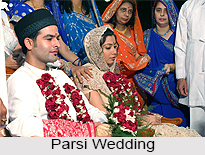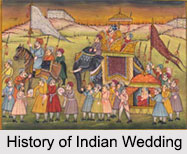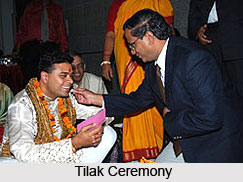 Fire is the most sacred element in the Parsi community and practically no ritual is complete without the use of fire. A Parsi wedding is full of gaiety and laughter. The `achoo meecho` (removing the evil eye) is performed before every single ceremony. The auspicious days to conduct weddings are either the first day of the month (`Hormazd Roe`) or the twentieth day of the month (`Behram Roj`). It is believed that on `Behram Roj` the angel of victory or `Behram` presides over the ceremonies. Most Parsi weddings take place in the evening, a little after sunset.
Fire is the most sacred element in the Parsi community and practically no ritual is complete without the use of fire. A Parsi wedding is full of gaiety and laughter. The `achoo meecho` (removing the evil eye) is performed before every single ceremony. The auspicious days to conduct weddings are either the first day of the month (`Hormazd Roe`) or the twentieth day of the month (`Behram Roj`). It is believed that on `Behram Roj` the angel of victory or `Behram` presides over the ceremonies. Most Parsi weddings take place in the evening, a little after sunset.
The pre wedding rituals or customs comprises the Madhavsaro that is celebrated four days before the lagan, the families of the bride and groom each plant a young tree in a pot, while recitation of prayers by the family priest, and place this at the entrance of their homes. This is usually a mango plant and is treated as a symbol of fertility. The plant is watered every morning till the eighth day after the wedding and then planted elsewhere.
Pre Wedding Rituals
Rupia Peravanu: This is the unofficial engagement when both families acknowledge and give their assent for the marriage. During the ceremony ladies from the groom`s family (usually 5 or 7 but never more than 9) proceed to the bride`s home. They are welcomed at the door by the bride`s mother, who performs the "achoo meecho" (removal of the evil eye). This is always done at the doorstep and is a regular custom at weddings.
A female member of the family holds a silver/silver-plated tray, containing a `kutli` (spout less mug) of water, some rice, "sakar" (large sugar crystals), rose petals, a raw egg, a coconut and some `kharak` (dried dates). She first takes the egg and passes it around the head of the recipient six times in a clockwise motion, and once in an anti-clockwise motion. The egg is then broken on the ground, thus removing the evil eye completely. The exact same procedure is followed with the coconut.
In the same way as the egg and the coconut, the tray is then rotated around the head of the recipient and some water is sprinkled on both sides. After this the girl holding the tray hands over the rice and the `sakar` to the person performing the ceremony, who in turn puts the `sakar` into the recipient`s mouth. The rice is then thrown over the head of the recipient. The recipient of the `achoo meecho` now touches the feet of the person performing the ceremony and enters the house placing her right foot forward. After the `achoo meecho`, the groom`s family members enter the bride`s home.
Wedding Day Rituals
Nahan is the day of the lagan. On this day the staircase, doorway and gate is decorated with beautiful decorative designs of rangoli. According to the Zoroastrians the time immediately after sunset or very early in the morning is considered auspicious for marriage. For the marriage ceremony the bride dresses in her madhavate the white, ornate wedding sari given by her parents, while the groom wears the traditional Parsi dagli and feta a white kurta like garment and a black cap.
Achoo meecho ceremony: The Parsi lagan is called Achoo meecho, which takes place either at a baug or at an agiary (the fire temple). A stage is build up for the couple and before they step on it, the groom first, a ritual called achoo meecho is performed. The bride`s mother takes a tray with a raw egg, supari, rice, coconut, dates and water and begins the ceremony with her son-in-law to be. In Ara antar ceremony the couple is made to sit facing each other with a cloth held between them, so they cannot see the other. Now the senior of the two priests places the right hand of the bride into the right hand of the groom. Then he passes a piece of cloth around both the chairs on which the couple is seated, enclosing them in a circle. The ends of the cloth are tied together. This knot strictly speaks the `marriage knot`.
Hathevaro (Hand fastening): After tying the marriage knot, which symbolically encloses the bridal couple in a circle of unity, the priest proceeds to fasten the couple`s right hands in a `raw twist` (several threads are twined into one and tied). The `raw twist` is tied around the couple`s hands seven times. After the hands are tied, the same `raw twist is passed around the bridal couple seven times and then finally it is passed seven times around the knot of the cloth, which was tied around the chairs.
At the end of this ritual, the servant who was holding the fire-vase places the frankincense on the fire. Immediately after this, the cloth separating the couple is dropped down and the couple sprinkles a few grains of rice on each other. The rice, at this time is held in their left hands.
Showering of rice by the couple: The ladies urge the bride and groom to be the first one to throw the rice grains at the other. It is believed that the one to throw the rice first, at the signal, will be the one who will lead the marriage, and be foremost in loving and respecting the other! As a mark of blessing the priests also shower rice on the couple.
Ashirwaad: Both officiating priests recite what is known as the `Paevandnameh` or `ashirwaad` (blessing). This recital consists of admonitions, prayers and benedictions. Once the admonitions are over, the priests recite the `benedictions` invoking the favour of virtues from the `Yazatas` (angels). The next set of prayers in this wedding ceremony is made in honour of the dear departed souls. The idea of praying to the dead is basically to wish the couple with some of the great qualities, which the dead possessed. Another set of benedictions follow known as the `tandarusti`. These are meant to invoke the blessings of the Almighty in granting the bridal couple good health and vigor and a healthy progeny.
Post Wedding Rituals
In the post-wedding rituals the reception is held in a grand manner with varied menu of food, drink and music. The party is a whole night affair where all the guests have a lovely time. The menu mainly comprises of traditional Parsi dishes like Parsi bhonu like sarya (crisps), achaar - rotli (pickle and rotis), patra ni macchi (steamed fish), salli margi (chicken with potato crisps), lagan nu custard, pulao-dal and ice cream. The wedding ceremony ends with the couple being accompanied home by the bride`s family and achoo meecho being performed once again by the groom`s mother for the well being of the couple.
More on Indian Religious Weddings
More on Indian Wedding Accessories
More on Types of Marriages
See also
 Fire is the most sacred element in the Parsi community and practically no ritual is complete without the use of fire. A Parsi wedding is full of gaiety and laughter. The `achoo meecho` (removing the evil eye) is performed before every single ceremony. The auspicious days to conduct weddings are either the first day of the month (`Hormazd Roe`) or the twentieth day of the month (`Behram Roj`). It is believed that on `Behram Roj` the angel of victory or `Behram` presides over the ceremonies. Most Parsi weddings take place in the evening, a little after sunset.
Fire is the most sacred element in the Parsi community and practically no ritual is complete without the use of fire. A Parsi wedding is full of gaiety and laughter. The `achoo meecho` (removing the evil eye) is performed before every single ceremony. The auspicious days to conduct weddings are either the first day of the month (`Hormazd Roe`) or the twentieth day of the month (`Behram Roj`). It is believed that on `Behram Roj` the angel of victory or `Behram` presides over the ceremonies. Most Parsi weddings take place in the evening, a little after sunset.



















